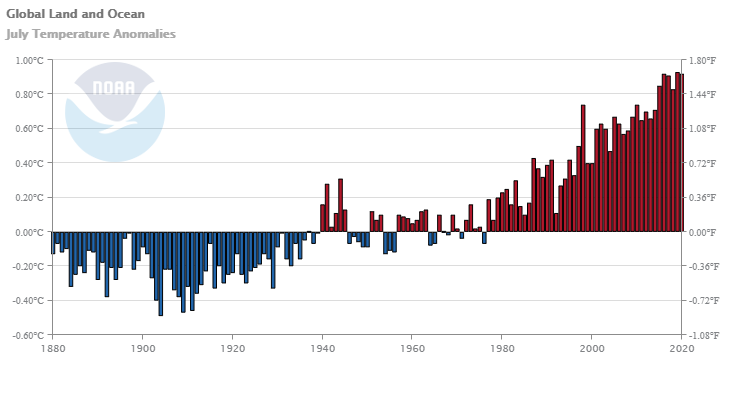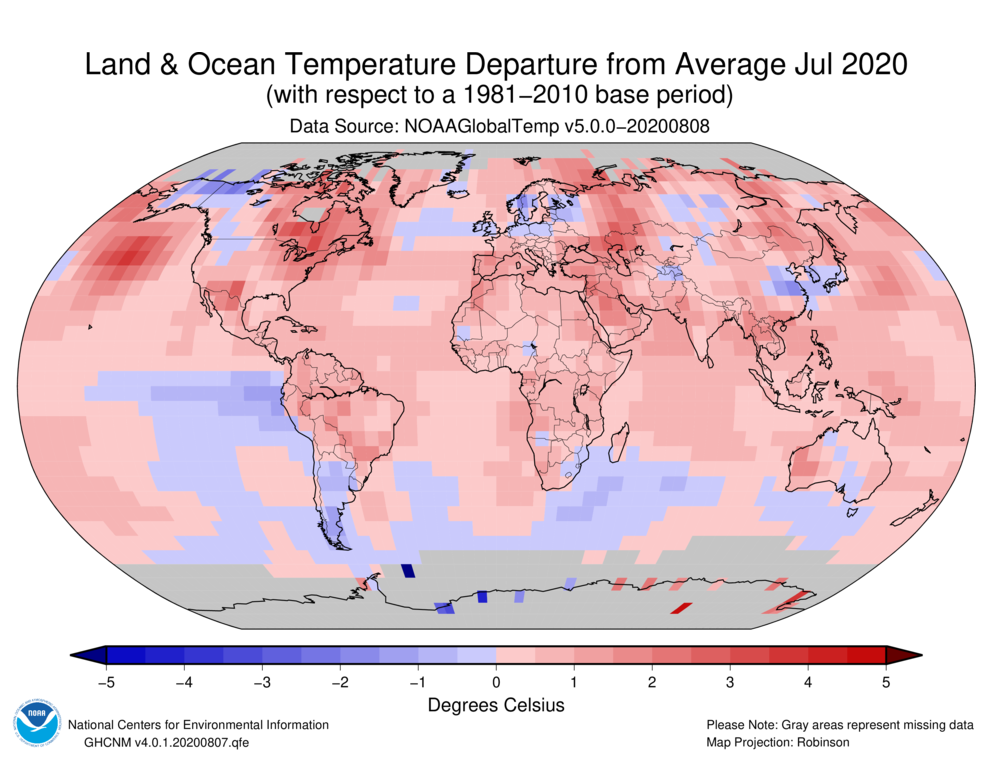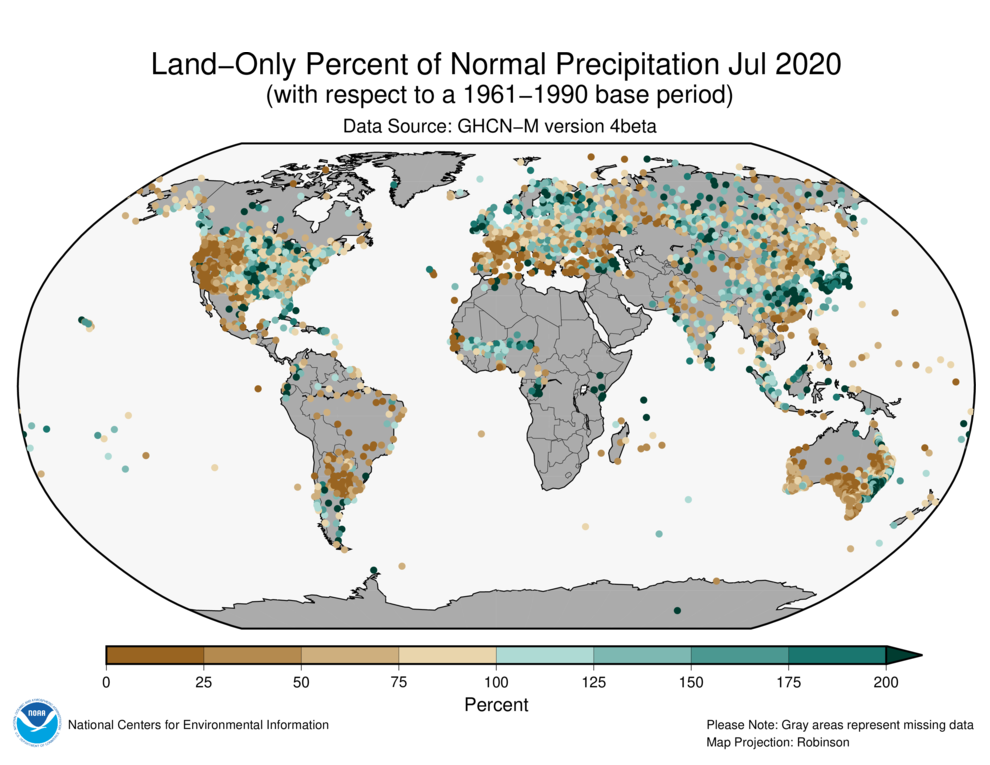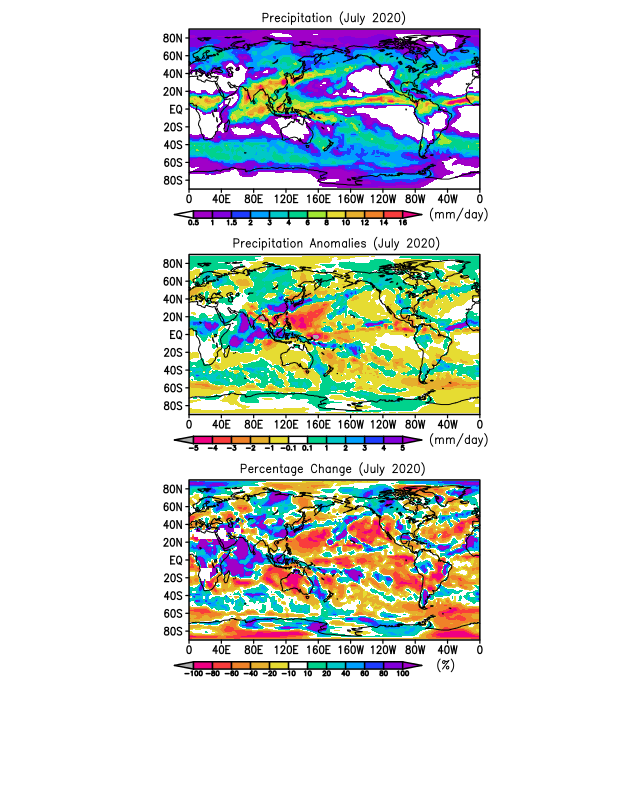Introduction
Temperature anomalies and percentiles are shown on the gridded maps below. The anomaly map on the left and the percentiles map on the right are a product of a merged land surface temperature (Global Historical Climatology Network, GHCN) and sea surface temperature (ERSST version 5) anomaly analysis. The anomalies maps tell us whether the temperature observed for a specific place and time period was warmer or cooler than a reference value and by how much. While the percentile map provides additional information by placing the temperature anomaly observed into historical perspective, showing how the most current month, season or year compares with the past. Temperature anomalies for land and ocean are analyzed separately and then merged to form the global analysis. For more information, please visit NCEI's Global Surface Temperature Anomalies page.
Temperature
In the atmosphere, 500-millibar height pressure anomalies correlate well with temperatures at the Earth's surface. The average position of the upper-level ridges of high pressure and troughs of low pressure—depicted by positive and negative 500-millibar height anomalies on the July 2020 map—is generally reflected by areas of positive and negative temperature anomalies at the surface, respectively.
Monthly Temperature: July 2020
The July 2020 global land and ocean surface temperature of 0.92°C (1.66°F) above the 20th century average tied with 2016 as the second highest July global temperature since records began in 1880. This value was only 0.01°C (0.02°F) shy of tying the record warm July of 2019. July 2020 was the 44th consecutive July and the 427th consecutive month with temperatures, at least nominally, above the 20th century average. Nine of the 10 warmest Julys on record have occurred since 2010. The six warmest Julys on record have occurred since 2015.
The month was characterized by warmer-than-average temperatures across much of the global land and ocean surface. The most notable warm temperature departures of +2.0°C (+3.6°F) were present across the North Pacific Ocean, the southwestern and northeastern contiguous U.S., eastern Canada, and across parts of western Asia and eastern Antarctica. Record-warm July temperatures were widespread across the North Indian Ocean, southeastern Asia, and the western Pacific Ocean. Other areas with record-warm July temperatures were present across parts of the Caribbean Sea, northern South America, North America, and the North Pacific Ocean. Overall, July 2020 had 8.67% of the world's land and ocean surfaces with a record July temperature. This was the second highest percentage for July record warm temperatures across the globe since records began in 1951, behind July 2015 (10.23%).
According to the July 2020 percentiles map, cooler-than-average July temperatures were limited to small parts of northern North America, the northern Atlantic Ocean, Scandinavia, eastern China, southern South America, and the eastern tropical Pacific Ocean. No land or ocean areas had a record-cold July temperature.
The global land-only surface temperature for July 2020 was the second highest on record at 1.23°C (2.21°F) above average and only 0.01°C (0.02°F) less than the record-warm July set in 2017. The global ocean-only surface temperature was the third highest on record at 0.80°C (1.44°F) above average. Only July 2016 and 2019 had a higher global ocean surface temperature.
The Northern Hemisphere land and ocean surface temperature was the highest in the 141-year record at 1.18°C (2.12°F) above average. This was 0.08°C (0.14°F) higher than the now second warmest July of 2019.
Regionally, the Caribbean region had its warmest July on record, with a temperature departure of 1.24°C (2.23°F) above average. This was 0.09°C (0.16°F) above the previous record set in 2016. The Caribbean region's five warmest Julys have occurred since 1998.
North America had its second warmest July on record at 1.31°C (2.36°F) above average. Only July of 2012 was warmer at 1.74°C (3.13°F). Asia had its third warmest July, while Africa and South America had their seventh and ninth warmest July in the 111-year continental record, respectively.
| July | Anomaly | Rank (out of 141 years) | Records | ||||
|---|---|---|---|---|---|---|---|
| °C | °F | Year(s) | °C | °F | |||
| Global | |||||||
| Land | +1.23 ± 0.27 | +2.21 ± 0.49 | Warmest | 2nd | 2017 | +1.24 | +2.23 |
| Coolest | 140th | 1884 | -0.71 | -1.28 | |||
| Ocean | +0.80 ± 0.15 | +1.44 ± 0.27 | Warmest | 3rd | 2019 | +0.83 | +1.49 |
| Coolest | 139th | 1909 | -0.50 | -0.90 | |||
| Land and Ocean | +0.92 ± 0.18 | +1.66 ± 0.32 | Warmest | 2nd | 2019 | +0.93 | +1.67 |
| Coolest | 140th | 1904 | -0.49 | -0.88 | |||
| Ties: 2016 | |||||||
| Northern Hemisphere | |||||||
| Land | +1.30 ± 0.22 | +2.34 ± 0.40 | Warmest | 2nd | 2012 | +1.35 | +2.43 |
| Coolest | 140th | 1884 | -0.71 | -1.28 | |||
| Ties: 2010 | |||||||
| Ocean | +1.11 ± 0.14 | +2.00 ± 0.25 | Warmest | 1st | 2020 | +1.11 | +2.00 |
| Coolest | 141st | 1904 | -0.58 | -1.04 | |||
| Land and Ocean | +1.18 ± 0.20 | +2.12 ± 0.36 | Warmest | 1st | 2020 | +1.18 | +2.12 |
| Coolest | 141st | 1904 | -0.60 | -1.08 | |||
| Southern Hemisphere | |||||||
| Land | +1.07 ± 0.13 | +1.93 ± 0.23 | Warmest | 5th | 2017 | +1.39 | +2.50 |
| Coolest | 137th | 1891 | -0.85 | -1.53 | |||
| Ocean | +0.56 ± 0.15 | +1.01 ± 0.27 | Warmest | 7th | 2016 | +0.70 | +1.26 |
| Coolest | 135th | 1909 | -0.44 | -0.79 | |||
| Ties: 2009 | |||||||
| Land and Ocean | +0.65 ± 0.15 | +1.17 ± 0.27 | Warmest | 7th | 2016, 2019 | +0.76 | +1.37 |
| Coolest | 135th | 1909 | -0.44 | -0.79 | |||
| Arctic | |||||||
| Land and Ocean | +1.37 ± 0.09 | +2.47 ± 0.16 | Warmest | 5th | 2016 | +1.83 | +3.29 |
| Coolest | 137th | 1912 | -1.21 | -2.18 | |||
The most current data can be accessed via the Global Surface Temperature Anomalies page.
Select national information is highlighted below. Please note that different countries report anomalies with respect to different base periods. The information provided here is based directly upon these data:
- Warmer-than-average temperatures were present across much of Ontario, Canada, with temperatures ranging between 1.0°–4.0°C (1.8°–7.2°F) above average. Of note, the Moosonee Airport had a mean temperature of 19.2°C (66.6°F), which is 3.4°C (6.1°F) above average and the highest mean temperature recorded in the area.
- July 2020 was Spain's third warmest July in the nation's 56-year record. The national temperature of 26.0°C (78.8°F) was 2.0°C (3.6°F) above the 1981–2010 average. Only Julys of 2006 and 2015 were warmer. Eight of Spain's 10 warmest Julys on record have occurred since 2001. The nation's July 2020 maximum temperature was 2.3°C (4.1°F) above average and the second warmest July maximum temperature on record, behind July 2015.
- France's July 2020 national temperature was 0.9°C (1.6°F) above average—the 16th warmest July since national records began in 1900. July 2020 marked the nation's 14th consecutive month with temperatures, at least nominally, above average. Unusually warm temperatures affected parts of southwestern France at the end of the month, with maximum temperatures exceeding 40.0°C (104.0°F) and many stations setting new maximum temperature records. Of note, the district of Socoa had a maximum temperature of 41.9°C (107.4°F) on July 30, a new all-time record for this station and besting its previous record set in 2003.
- De Bilt, Netherlands had a July temperature of 17.0°C (62.6°F), which is 0.9°C (1.6°F) below average. This was De Bilt's coolest July since 2011.
- The Kingdom of Bahrain's July 2020 mean temperature was 3.0°C (5.4°F) above average and tied with 2017 as the highest mean July temperature since national records began in 1902. The nation's maximum temperature was the second highest for July at 3.8°C (6.8°F) above average, trailing behind 2017. During the month, Bahrain had a total of 23 days with temperatures exceeding 40.0°C (104.0°F), which is the highest number of days for the month of July and surpassing the previous records set in 2002 and 2017 by 1 day.
- Hong Kong had its warmest July on record, with a mean temperature that was 1.5°C (2.7°F) above average. According to the Hong Kong Observatory, Hong Kong had a total of 21 hot nights, resulting in the highest number of hot nights for any month on record.
- Argentina had cooler-than-average conditions during July 2020. Averaged as a whole, the nation's July temperature was 0.9°C (1.62°F) below average and the 12th coolest July since Argentina's records began in 1961. According to Argentina's Servicio Meteorológico Nacional, July 2020 was the first month of the year to have below-average temperatures. Regionally, the provinces of Patagonia and Córdoba had a July temperature that ranked among the 10 coldest Julys on record.
- Australia, as a whole, had a warmer-than-average July, with a national mean temperature that was 0.99°C (1.78°F) above the 1961–1990 average. This was Australia's 15th warmest July in the nation's 111-year record. The national maximum temperature was 1.54°C (2.77°F) above average and the seventh highest July maximum temperature on record. Regionally, Western Australia had its second and third highest July maximum and mean temperature on record, respectively.
- New Zealand had its 11th warmest July since national records began in 1909, with a national temperature that was 0.8°C (1.4°F) above average. July 2020 marked the 42nd consecutive month with temperatures, at least nominally, above average.
Year-to-date Temperature: January–July 2020
The January–July global land and ocean surface temperature departure was 1.05°C (1.89°F) above average and the second warmest such period in the 141-year record. Only the year-to-date period of 2016 is warmer by 0.04°C (0.07°F). According to a statistical analysis done by NCEI scientist, the year 2020 is very likely to rank among the five warmest years on record.
During January–July 2020, temperature departures of +2.0°C (+3.6°F) or higher were observed across parts of the North Pacific Ocean and across parts of northern Europe and across much of the northern half of Asia. Record-warm year-to-date temperatures were present across a large portion of northern Asia and across parts of Europe, southern China, Mexico, the Caribbean, South America, and the Atlantic, northern Indian, and Pacific oceans.
According to our regional analysis, Europe, Asia, the Caribbean region, and the Gulf of Mexico had their warmest January–July since regional records began in 1910. Europe had a year-to-date temperature departure of +2.10°C (+3.78°F), marking the first time the January–July temperature departure surpassed the 2.0°C (3.6°F) mark on record. This value surpassed the previous record set in 2014 by +0.12°C (+0.22°F). Europe's five warmest January–Julys on record have occurred since 2014.
For Asia, the year-to-date temperature departure of +2.57°C (+4.63°F) surpassed the now second warmest January–July set in 2016 by +0.48°C (0.86°F). Only January–July of 2016 and 2020 have a temperature departure surpassing 2.0°C (3.6°F).
The Caribbean region's January–July 2020 temperature of 1.06°C (1.91°F) was the warmest such period in the 111-year record, exceeding the previous record set in 2016 by only 0.01°C (0.02°F). The Gulf of Mexico had a temperature that was 0.97°C (1.75°F) above average and the highest since regional records began in 1910. This value surpassed the previous record set in 1943 and again in 2017 by +0.10°C (+0.18°F).
France's January–July temperature of 13.83°C (56.9°F) was 1.68°C (3.02°F) above the 1981–2010 average and the highest such period since national records began in 1900. This value surpassed the previous record set in 2007 by +0.34°C (0.61°F).
| January–July | Anomaly | Rank (out of 141 years) | Records | ||||
|---|---|---|---|---|---|---|---|
| °C | °F | Year(s) | °C | °F | |||
| Global | |||||||
| Land | +1.73 ± 0.18 | +3.11 ± 0.32 | Warmest | 2nd | 2016 | +1.77 | +3.19 |
| Coolest | 140th | 1893 | -0.76 | -1.37 | |||
| Ocean | +0.79 ± 0.17 | +1.42 ± 0.31 | Warmest | 2nd | 2016 | +0.84 | +1.51 |
| Coolest | 140th | 1904, 1911 | -0.50 | -0.90 | |||
| Land and Ocean | +1.05 ± 0.18 | +1.89 ± 0.32 | Warmest | 2nd | 2016 | +1.09 | +1.96 |
| Coolest | 140th | 1911 | -0.53 | -0.95 | |||
| Northern Hemisphere | |||||||
| Land | +1.95 ± 0.19 | +3.51 ± 0.34 | Warmest | 2nd | 2016 | +1.98 | +3.56 |
| Coolest | 140th | 1883, 1893 | -0.86 | -1.55 | |||
| Ocean | +0.97 ± 0.17 | +1.75 ± 0.31 | Warmest | 1st | 2020 | +0.97 | +1.75 |
| Coolest | 141st | 1904 | -0.53 | -0.95 | |||
| Land and Ocean | +1.34 ± 0.18 | +2.41 ± 0.32 | Warmest | 2nd | 2016 | +1.35 | +2.43 |
| Coolest | 140th | 1893 | -0.58 | -1.04 | |||
| Southern Hemisphere | |||||||
| Land | +1.16 ± 0.15 | +2.09 ± 0.27 | Warmest | 3rd | 2019 | +1.32 | +2.38 |
| Coolest | 139th | 1917 | -0.82 | -1.48 | |||
| Ocean | +0.67 ± 0.18 | +1.21 ± 0.32 | Warmest | 3rd | 2016 | +0.76 | +1.37 |
| Coolest | 139th | 1911 | -0.50 | -0.90 | |||
| Ties: 2019 | |||||||
| Land and Ocean | +0.75 ± 0.17 | +1.35 ± 0.31 | Warmest | 3rd | 2016 | +0.83 | +1.49 |
| Coolest | 139th | 1911 | -0.53 | -0.95 | |||
| Arctic | |||||||
| Land and Ocean | +2.27 ± 0.30 | +4.09 ± 0.54 | Warmest | 3rd | 2016 | +2.77 | +4.99 |
| Coolest | 139th | 1902 | -1.39 | -2.50 | |||
Precipitation
July Precipitation
The maps shown above represent precipitation anomalies (left, using a base period of 1961–1990) and precipitation percent of normal (right, using the period of record) based on the GHCN dataset of land surface stations. As is typical, precipitation anomalies during July 2020 varied significantly around the world. July 2020 precipitation was generally drier than normal across the western contiguous U.S., southern Mexico, Brazil, Paraguay, Uruguay, northern Argentina, western and southern Europe, western and southern Australia, and across parts of western and eastern Asia. Wetter-than-average conditions were present across parts of the eastern half of the contiguous U.S., northern South America, southern Argentina, northern and eastern Europe, central Africa, southeastern Australia, central and eastern Russia, Japan, and western and southeastern China.
Select national information is highlighted below. (Please note that different countries report anomalies with respect to different base periods. The information provided here is based directly upon these data):
- Monsoonal rains at the start of the month triggered floods and landslides across central and western Nepal. According to the Disaster Risk Reduction Authority in Nepal, over 110 fatalities were reported and over 600 families were affected. Extensive damages were also reported due to the floods and landslides, with about 300 houses damaged and roads blocked by debris.
- Torrential rain fell across parts of Bangladesh, causing more than 90 fatalities and affecting 4.7 million people. According to ReliefWeb, over 980,000 homes and 150,000 hectares of paddy fields were inundated by floods. It was reported that 24% of the country was flooded.
- Australia's July 2020 precipitation total was 43% below average. Most regions had below average conditions during the month, with the Northern Territory having the largest deficit at 88% below normal. South Australia had its lowest July precipitation since July 1997 and Tasmania had its second driest July, behind 1957.
Global Precipitation Climatology Project (GPCP)
The following analysis is based upon the Global Precipitation Climatology Project (GPCP) Interim Climate Data Record. It is provided courtesy of the GPCP Principal Investigator team at the University of Maryland.
The Global Precipitation Climatology Project (GPCP) monthly data set is a long-term (1979-present) analysis (Adler et al., 2018) using a combination of satellite and gauge information. An interim GPCP analysis completed within ~10 days of the end of the month allows its use in climate monitoring.
The middle of Northern Hemisphere summer finds most of the tropical rainfall north of the Equator with the Asian monsoon especially active (Fig. 1, top panel). The Indian Ocean south of the Equator again this month as last month has significant rainfall, likely associated with warm SSTs north of 20°S. The ITCZ stretches eastward across the Maritime Continent, with a narrow band across the entire Pacific, a maximum in very northern South America and then across the Atlantic and Africa. Further north the mean map shows the heavy rain areas through India and China connected to the maximum across Japan and extending northeastward narrowing and weakening across the North Pacific into Canada. The broad precipitation maximum in eastern North America repeats this connection to the narrower precipitation feature across the North Atlantic into western and then Europe and northern Asia. In the Southern Hemisphere the South Pacific Convergence Zone (SPCZ) extends southeastward from New Guinea across the South Pacific. The circumpolar band at ~50°S is in its far poleward position here in mid-winter (in the Southern Hemisphere), with lower latitude peaks southeast of Australia and South America.
The global anomaly map (Fig. 1, middle panel) indicates multiple excess and deficit precipitation areas for the month. The largest signals are over Asia and the western Pacific. The Indian Ocean has large areas of large positive anomalies and related warm SSTs. Over land the rainfall excess in China last month continued in generally the same area through July resulting in extended flooding there and with an extension to the east across Korea and southern Japan with devastating floods and landslides occurring there also, especially early in the month. To the south of this heavy rainfall area across China and Japan, a broad area of rainfall deficit extends from the western Pacific westward across the Philippines, Indochina and into the Indian sub-continent. The western Pacific large negative rainfall feature is a result of the sub-tropic dry zones pushing in to the west and may be partly related to the lack of much tropical cyclone activity during July, despite relatively warm waters. However, a relatively small area in southern Nepal, northeast India and northern Bangladesh suffered floods early in the month. The small positive rainfall anomaly can be discerned in that location and somewhat better in percent anomaly chart (Fig. 1, bottom panel). The positive anomaly in the Arabian Sea also edges into western India, including Mumbai which recorded floods during the month and extending into August.
In the central and eastern Pacific (east of the 180°) SSTs have decreased recently and are below average. For example, the Nino3.4 index (an SST anomaly in a particular area which is used as an indicator of the El Niño Southern Oscillation [ENSO] phenomenon) has decreased to about -1°, sliding into weak La Niña territory. West of 180° longitude SSTs are above normal. This SST pattern is also reflected in the rainfall anomaly field along the Equator, where negatives dominate in the central and east Pacific and a relatively narrow positive anomaly centered over Borneo extends east and west from there. Along the ITCZ in the eastern Pacific an east-west oriented positive rain anomaly is partially related to tropical cyclone activity, with an extension to the northwest which marks the path of Hurricane Douglas which brushed by the Hawaii Islands, as can be seen in each of the maps.
Tropical cyclones were also in the news in the Atlantic where above normal SSTs and even the weak La Niña conditions in the Pacific are associated with a very active early season so far. The ITCZ across Africa and out into the eastern Atlantic has above average rainfall, linked to frequent waves generated over Africa, with a subset becoming tropical depressions and stronger storms further to the west over the ocean. In fact July 2020 set the record for number of named storms (9) so early in the season and this activity is evident in the rainfall maps with the anomalies (see the middle and bottom panels) showing a positive anomaly swath from the center part of the tropical Atlantic northwestward toward Florida and then more weakly along the mid-Atlantic coast. This monthly anomaly feature is related to a number of storms in the area, including Tropical Storm Fay and to finish off the month, Hurricane Isaias, the record setter, which formed just at the end of the month. Another positive anomaly swath is evident from the Gulf of Mexico into south Texas and Mexico also associated with flooding from Tropical Storm Hanna.
Over the U.S. the west was dry, with general drought conditions in the southwest, while the middle portion of the country had above average rainfall, with the east coast generally below average, except for the small portion affected by heavy rain from Isaias at the end of the month. The western dryness is connected with a larger-scale pattern over the mid-latitude eastern Pacific, while the east coast below average area is linked with similar departure values over the Atlantic, except for the storm track breaking through along the eastern U.S. coast.
Background discussion of long-term means, variations and trends of global precipitation can be found in Adler et al. (2017).
References
- Adler, R., G. Gu, M. Sapiano, J. Wang, G. Huffman 2017. Global Precipitation: Means, Variations and Trends During the Satellite Era (1979-2014). Surveys in Geophysics 38: 679-699, doi:10.1007/s10712-017-9416-4
- Adler, R., M. Sapiano, G. Huffman, J. Wang, G. Gu, D. Bolvin, L. Chiu, U. Schneider, A. Becker, E. Nelkin, P. Xie, R. Ferraro, D. Shin, 2018. The Global Precipitation Climatology Project (GPCP) Monthly Analysis (New Version 2.3) and a Review of 2017 Global Precipitation. Atmosphere. 9(4), 138; doi:10.3390/atmos9040138
- Gu, G., and R. Adler, 2022. Observed Variability and Trends in Global Precipitation During 1979-2020. Climate Dynamics, doi:10.1007/s00382-022-06567-9
- Huang, B., Peter W. Thorne, et. al, 2017: Extended Reconstructed Sea Surface Temperature version 5 (ERSSTv5), Upgrades, validations, and intercomparisons. J. Climate, doi: 10.1175/JCLI-D-16-0836.1
- Huang, B., V.F. Banzon, E. Freeman, J. Lawrimore, W. Liu, T.C. Peterson, T.M. Smith, P.W. Thorne, S.D. Woodruff, and H-M. Zhang, 2016: Extended Reconstructed Sea Surface Temperature Version 4 (ERSST.v4). Part I: Upgrades and Intercomparisons. J. Climate, 28, 911-930, doi:10.1175/JCLI-D-14-00006.1.
- Menne, M. J., C. N. Williams, B.E. Gleason, J. J Rennie, and J. H. Lawrimore, 2018: The Global Historical Climatology Network Monthly Temperature Dataset, Version 4. J. Climate, in press. https://doi.org/10.1175/JCLI-D-18-0094.1.
- Peterson, T.C. and R.S. Vose, 1997: An Overview of the Global Historical Climatology Network Database. Bull. Amer. Meteorol. Soc., 78, 2837-2849.
- Vose, R., B. Huang, X. Yin, D. Arndt, D. R. Easterling, J. H. Lawrimore, M. J. Menne, A. Sanchez-Lugo, and H. M. Zhang, 2021. Implementing Full Spatial Coverage in NOAA's Global Temperature Analysis. Geophysical Research Letters 48(10), e2020GL090873; doi:10.1029/2020gl090873.
 NOAA's National Centers for Environmental Information
NOAA's National Centers for Environmental Information













